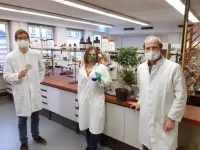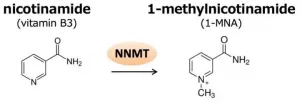Bacterium produces pharmaceutical all-purpose weapon
Study should significantly facilitate research into the promising substance
2021-01-11
(Press-News.org) For some years, an active substance from the leaves of an ornamental plant has been regarded as a possible forerunner of a new group of potent drugs. So far, however, it has been very laborious to manufacture it in large quantities. That could now change: Researchers at the University of Bonn (Germany) have identified a bacterium that produces the substance and can also be easily cultivated in the laboratory. The results are published in the journal Nature Communications.
The coralberry currently once again adorns many living rooms: In winter it bears bright red fruits, which make it a popular ornamental plant at this time of year. For pharmacists, however, it is interesting for a different reason: It contains an active substance that has emerged in recent years as a beacon of hope against asthma and certain types of cancer.
Unfortunately, obtaining the substance with the cryptic name FR900359 (abbreviated: FR) in larger quantities is rather laborious. Cultivating the plants in greenhouses takes many weeks; moreover, the yield can vary enormously depending on the specimen. Incidentally, they do not produce the active ingredient themselves, but have bacteria in their leaves that do it for them. "However, these only grow in the coralberry and cannot be cultivated in the laboratory," explains Dr. Max Crüsemann of the Institute of Pharmaceutical Biology at the University of Bonn.
Complex assembly line
Manufacturing FR is a complex undertaking. The bacteria have a special assembly line for this purpose, in which a number of enzymes work hand in hand. The bacterial genetic makeup specifies how this assembly line must be set up. "We have now searched huge databases for other microorganisms that also have these genes for FR synthesis," Crüsemann explains. "In the process, we came across another bacterium. Unlike its coralberry relative, it does not grow in plants, but in soil and is easily propagated in culture media."
This finding should greatly facilitate the production of FR in the future. However, it also allows more detailed insights into how the active substance works. "We have known for several years that FR inhibits an important group of signaling molecules in cells, the Gq proteins," explains Cornelia Hermes of the Institute of Pharmaceutical Biology. "That makes FR extremely effective: To date, no other compound is known to inhibit Gq proteins with similar potency."
Hermes is pursuing her doctoral studies in the group of Max Crüsemann and Prof. Gabriele König and, together with her colleague Dr. René Richarz, was responsible for a large part of the study now published. One of the questions the researchers explored was, why FR is such a good inhibitor. The molecule consists of two parts, the actual core and a side chain that is attached to it like an arm. Both are produced separately and then linked together. "The side chain is essential for the function of FR," Crüsemann explains. "When it is absent or even slightly modified, the inhibitory effect on Gq proteins decreases significantly."
Central control station in the cell
The function of Gq proteins in the cell is similar to that of the emergency call center of a city: They are the place where various signals from outside the cell converge. This activates them and then in turn certain metabolic processes are switched on or off. Instead of inhibiting numerous signaling pathways, it is therefore sufficient to inhibit the Gq protein in order to achieve a therapeutic effect. This means that FR is extremely effective, but also, if it were administered to the whole body, very toxic. "The goal is therefore to administer FR only to cells with pathologically altered behavior," Crüsemann explains. Bacterial genes can be easily and specifically modified nowadays. "In this way, we can in principle generate FR variants with specific properties, such as those that are transported precisely to certain cells in the body and only do their work there," says the pharmaceutical biologist.
The history of the FR molecule is therefore likely to be extended by another chapter as a result of the study: The active substance was discovered more than 30 years ago by Japanese researchers. In 2015, its biological mode of action was described by the research groups led by Professors Gabriele M. König and Evi Kostenis at the Institute of Pharmaceutical Biology. This work now forms the basis for a research group of the German Research Foundation (DFG). Today, more and more research groups around the world are exploring the potential of the molecule. With the newly discovered bacterium, they now have a new tool at hand.
INFORMATION:
Publication: Cornelia Hermes, René Richarz, Daniel A. Wirtz, Julian Patt, Wiebke Hanke, Stefan Kehraus, Jan Hendrik Voß, Jim Küppers, Tsubasa Ohbayashi, Vigneshwaran Namasivayam, Judith Alenfelder, Asuka Inoue, Peter Mergaert, Michael Gütschow, Christa E. Müller, Evi Kostenis, Gabriele M. König & Max Crüsemann:
Thioesterase-mediated side chain transesteri ?cation generates potent Gq signaling inhibitor FR900359; Nature Communications; DOI: 10.1038/s41467-020-20418-3
[Attachments] See images for this press release:

ELSE PRESS RELEASES FROM THIS DATE:
2021-01-11
CHAMPAIGN, Ill. -- For years, researchers have worked to repurpose excess atmospheric carbon dioxide into new chemicals, fuels and other products traditionally made from hydrocarbons harvested from fossil fuels. The recent push to mitigate the climactic effects of greenhouse gases in the atmosphere has chemists on their toes to find the most efficient means possible. A new study introduces an electrochemical reaction, enhanced by polymers, to improve CO2-to-ethylene conversion efficiency over previous attempts.
The results of the study led by University of Illinois Urbana-Champaign chemistry ...
2021-01-11
Metabolites are organic molecules that take part in or are created during the biochemical reactions constantly taking place in an organism. For the human body, more than 110,000 metabolites have been identified. Metabolites play a role in metabolic syndrome, which is the situation in which several medical conditions occur simultaneously; the conditions include obesity, high blood pressure and high blood sugar. Metabolic syndrome is associated with a higher risk of developing cardiovascular disease, type-2 diabetes and different kinds of cancer. The presence of certain metabolites can be an indicator for particular pathological ...
2021-01-11
This most likely explains the augmented response of the immune system and the more severe disease progression. However, certain hypertension-reducing drugs known as ACE inhibitors can have a beneficial effect. They not only lower blood pressure, but also counteract immune hyperactivation. The scientists have now published their findings in the journal Nature Biotechnology.
More than one billion people worldwide suffer from high blood pressure, or hypertension. Of the more than 75 million people around the world who have become infected with the SARS-CoV-2 virus worldwide so far, more than 16 million also have hypertension. These patients are more likely to become severely ill, which in turn results in an increased ...
2021-01-11
NEW YORK, NY (Jan. 11, 2021)--Thousands of different genetic mutations have been implicated in cancer, but a new analysis of almost 10,000 patients found that regardless of the cancer's origin, tumors could be stratified in only 112 subtypes and that, within each subtype, the Master Regulator proteins that control the cancer's transcriptional state were virtually identical, independent of the specific genetic mutations of each patient.
The study, published Jan. 11 in Cell, confirms that Master Regulators provide the molecular logic that integrates the effect ...
2021-01-11
Philadelphia, January 11, 2021 - Children and adolescents with a family history of suicide attempts have lower executive functioning, shorter attention spans, and poorer language reasoning than those without a family history, according to a new study by researchers from the Lifespan Brain Institute (LiBI) of Children's Hospital of Philadelphia (CHOP) and the University of Pennsylvania. The study is the largest to date to examine the neurocognitive functioning of youth who have a biological relative who made a suicide attempt.
The findings, which were first published online last March, were published in the January 2021 edition of The Journal of Child Psychology and Psychiatry.
Researchers looked at 3,507 youth aged 8 to 21. Of those, ...
2021-01-11
Russian researchers have proposed a new method for synthesizing high-quality graphene nanoribbons -- a material with potential for applications in flexible electronics, solar cells, LEDs, lasers, and more. Presented in The Journal of Physical Chemistry C, the original approach to chemical vapor deposition, offers a higher yield at a lower cost, compared with the currently used nanoribbon self-assembly on noble metal substrates.
Silicon-based electronics are steadily approaching their limits, and one wonders which material could give our devices the next big push. Graphene, the 2D sheet of carbon atoms, comes to mind but for all its celebrated electronic properties, it does not have what it takes: Unlike silicon, graphene does not have the ability to switch between ...
2021-01-11
CHICAGO (January 11, 2021): A new study of liver transplant centers confirms that non-Hispanic white patients get placed on liver transplant waitlists at disproportionately higher rates than non-Hispanic Black patients. However, researchers went a step further as they identified key reasons for that disparity: disproportionate access to private health insurance, travel distance to transplant centers, and a potential lack of knowledge among both practitioners and patients about available options. The study was selected for the 2020 Southern Surgical Association Program and published as an "article in press" on the website of the Journal of the American College of Surgeons in advance of print.
"We found that the Black population was underrepresented at the vast majority of centers, ...
2021-01-11
All-solid-state batteries are the next-generation batteries that can simultaneously improve the stability and capacity of existing lithium batteries. The use of non-flammable solid cathodes and electrolytes in such batteries considerably reduces the risk of exploding or catching fire under high temperatures or external impact and facilitates high energy density, which is twice that of lithium batteries. All-solid-state batteries are expected to become a game changer in the electric vehicle and energy storage device markets. Despite these advantages, the low ionic conductivity of solid electrolytes combined with their high interfacial resistance and rapid deterioration reduce battery performance and life, thus limiting their commercialization.
The ...
2021-01-11
Special Issue: Tumor Microenvironment and Drug Delivery
Guest Editors: Huile Gao, West China School of Pharmacy, Sichuan University, Chengdu, China; Zhiqing Pang, Fudan University, Shanghai, China and Wei He, China Pharmaceutical University, Nanjing, China
The Journal of the Institute of Materia Medica, the Chinese Academy of Medical Sciences and the Chinese Pharmaceutical Association, Acta Pharmaceutica Sinica B (APSB) is a monthly journal, in English, which publishes significant original research articles, rapid communications and high quality reviews of recent advances in all areas of pharmaceutical sciences -- including pharmacology, pharmaceutics, medicinal chemistry, natural products, ...
2021-01-11
The Journal of the Institute of Materia Medica, the Chinese Academy of Medical Sciences and the Chinese Pharmaceutical Association, Acta Pharmaceutica Sinica B (APSB) is a monthly journal, in English, which publishes significant original research articles, rapid communications and high quality reviews of recent advances in all areas of pharmaceutical sciences -- including pharmacology, pharmaceutics, medicinal chemistry, natural products, pharmacognosy, pharmaceutical analysis and pharmacokinetics.
Featured papers in this issue are:
Berberine diminishes cancer cell PD-L1 expression and facilitates antitumor immunity via inhibiting the deubiquitination activity of CSN5 by authors Yang Liu, Xiaojia Liu, Na Zhang, Mingxiao Yin, Jingwen Dong, Qingxuan ...
LAST 30 PRESS RELEASES:
[Press-News.org] Bacterium produces pharmaceutical all-purpose weapon
Study should significantly facilitate research into the promising substance







